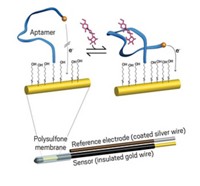Advertisement
Grab your lab coat. Let's get started
Welcome!
Welcome!
Create an account below to get 6 C&EN articles per month, receive newsletters and more - all free.
It seems this is your first time logging in online. Please enter the following information to continue.
As an ACS member you automatically get access to this site. All we need is few more details to create your reading experience.
Not you? Sign in with a different account.
Not you? Sign in with a different account.
ERROR 1
ERROR 1
ERROR 2
ERROR 2
ERROR 2
ERROR 2
ERROR 2
Password and Confirm password must match.
If you have an ACS member number, please enter it here so we can link this account to your membership. (optional)
ERROR 2
ACS values your privacy. By submitting your information, you are gaining access to C&EN and subscribing to our weekly newsletter. We use the information you provide to make your reading experience better, and we will never sell your data to third party members.
Analytical Chemistry
Aptamer-based sensors could measure drug levels in real time
General sensor platform makes measurements in awake animals and doesn’t depend on specific target’s chemistry
by Celia Henry Arnaud
January 12, 2017
| A version of this story appeared in
Volume 95, Issue 3

The few sensors that detect and measure molecules in the body depend on the specific chemistry of the target analyte. For example, glucose sensors quantify levels of the sugar thanks to glucose oxidase, which oxidizes glucose and nothing else.
But what about the vast range of metabolites, drugs, and other molecules that a doctor or patient might want to measure? “What we really want is a generic platform that works in vivo, something that can detect any molecule irrespective of its chemistry,” says Kevin W. Plaxco, a chemist at the University of California, Santa Barbara.
Now, Plaxco and his coworkers have made such a general platform that works even in animals that are awake and moving around (Proc. Natl. Acad. Sci. USA 2017, DOI: 10.1073/pnas.1613458114).
To do that, they use aptamers, ligand-binding nucleic acids, to bind to and detect a target molecule. To generate a signal, they modify those aptamers with an electrochemically active reporter molecule and tether the complex to electrodes. When the aptamers bind their targets, they fold up and change the electrochemical signal produced by the reporter. The team built the aptamer-decorated electrodes into a device that can be inserted into a vein in an animal so researchers can measure levels of a molecule in real time via changes in the electrical signals.
Plaxco’s group has been working on aptamer-based sensors for more than a decade. “When we first invented these sensors, they immediately worked in blood serum. Nobody else had a generic platform that would work continuously in blood serum for hours, making us optimistic that they’d work in vivo,” Plaxco says. “That turned out to be a big jump, though. We slowly chipped away at all the challenges.”
For example, they added a membrane to protect the sensor from fouling by blood cells. They also devised a way to correct for drift in the electrical signal over time.
The researchers made two types of sensors, one with an aptamer that binds the cancer drug doxorubicin and another with an aptamer that binds aminoglycoside-containing antibiotics. They used the sensors to measure clinically relevant drug concentrations in rats that were awake and freely moving.
“This is the first time aptamer sensors have been demonstrated in living animals,” says Yi Lu, a chemist at the University of Illinois, Urbana-Champaign, who also develops aptamer-based sensors. The method is “limited only by the aptamers that have been selected. The results are very promising for potential clinical applications.”
Plaxco wants to expand the platform to other targets. “We’re very excited about expanding it to drugs where the window between the minimum effective dose and the toxic dose is narrow,” he says. Such measurements would allow feedback-controlled drug delivery to keep concentrations at safe levels. He also wants to develop sensors for biomolecules such as creatinine, which could be used as a real-time indicator of kidney function.
“We’ve only put three sensors in the body so far, but in vitro we’ve had great success at converting aptamers into sensors,” Plaxco says. “We believe our platform is as general as aptamers are.”





Join the conversation
Contact the reporter
Submit a Letter to the Editor for publication
Engage with us on Twitter